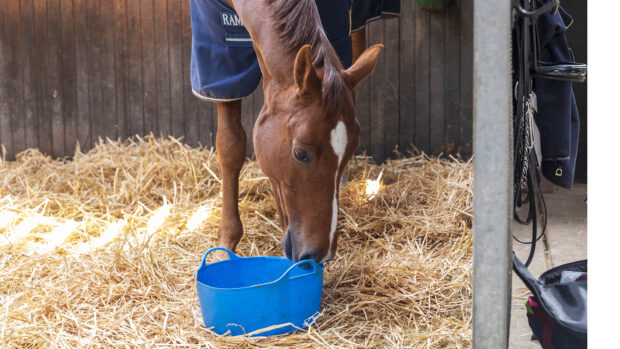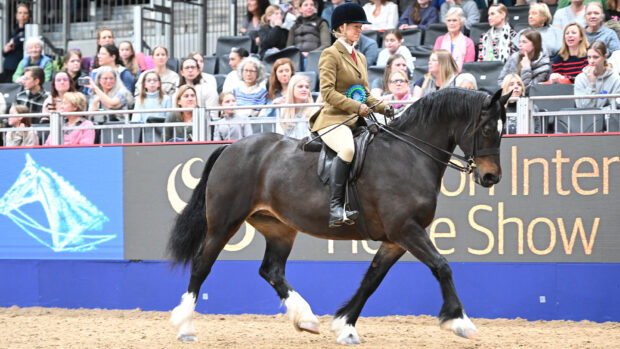Feeding bran mash to horses is long associated with traditional horsemanship practices. A straight feed composed of the outer coating of kernels of grain, bran is a by-product of milling grain for flour. Historically, it was mixed with warm water to make a tempting mash for working horses. It was believed to assist with recovery after hard work, replenishing lost fluids and promoting gut mobility. Some Horse & Hound readers still report feeding it today.
Moving with the times
There’s something very nostalgic – romantic, even – about watching your horse eagerly tuck in to a warming bowl of “equine porridge” after a hard day’s work. But as horsemanship practices have moved on, with many owners opting for nutritionally balanced compound feeds or feed balancers rather than straights, is the occasional mash still an appropriate feed for the working horse of 2024?
For Karen Coumbe MRCVS, H&H’s veterinary consultant, bran is not a frequent find in modern feed rooms. “Anecdotally it is said to help by providing fibre and, with the added fluid, reduces the risk of colic,” she tells H&H. “However, it is counterproductive to suddenly change feed by giving a bran mash to your horse.”
Karen adds that bran mash is of somewhat questionable nutritional value.
“Bran has a poor calcium to phosphorus ratio and it’s deficient in key nutrients such a lysine. Furthermore, if you feed huge amounts of bran long-term, horses can develop a condition known as ‘big head’, which is actually secondary hyperparathyroidism. This condition is extremely rare with modern, balanced diets.
“Feeding bran has become increasingly unpopular as although it is perceived as a laxative, it may also irritate the intestinal tract. Ultimately, bran mashes are traditional feeds that are now considered old-fashioned. Most yards no longer seem to feed them and, in fact, rarely have bran in their feed room. When it comes to appropriate nutrition, there are other modern, more sophisticated diets to be tried.”

Spillers Perform & Restore Mash | Amazon
This modern mash is formulated to support hydration, performance and post-exercise recovery
What is “big head” disease?
“Big head” disease or “bran disease”, is properly known as secondary hyperparathyroidism. It occurs in horses who become calcium deficient alongside consumption of excess phosphorus. This causes the horse to leach calcium from the bones to balance supplies elsewhere in the body. The bones form fibrous growths in place of the lost minerals, causing the head to take on an enlarged, deformed appearance. If caught early and the diet is changed, the damage can be reversed. If not, horses can be left with permanent skeletal damage.
Finding a balance
Independent equine nutritionist Clare MacLeod MSc RNutr tells us that while bran mashes should be fed with caution, wheat products similar to bran are still widely-used ingredients in compound feeds.
“The biggest problem with feeding bran mash to horses is that they are traditionally fed once a week,” she tells H&H. “In doing this, you disturb the horse’s healthy gut microbes. Traditionally, we change feeds gradually – it’s something we all know to do. As long as you feed it every day, and phase it in and out of the diet over the season, you avoid upsetting the microbiome. It’s lovely to treat our horses, but we need to respect their physiology, too.”
Clare, who pioneered her own Confident Horse Feeding Programme, also warned of the dangers of low-calcium-high-phosphorus intake. She adds: “Because bran is so high in phosphorus, you would need to add calcium to balance it out. You can used limestone flour to do this, I recommend a ratio of 42g per kilo of bran.
“Bran can be a useful feed. It’s moderately high in fibre and protein and low in sugar. It’s got a moderately high starch content, so it’s not suitable for low-starch diets, but it’s not a bad feed when fed appropriately and balanced correctly.”

NAF Limestone Flour | Amazon
Limestone flour is a source of calcium that you can add to cereal diets.
You might also like…

5 expert tips for feeding horses this winter

The 10 golden rules of feeding horses

Subscribe to Horse & Hound magazine today – and enjoy unlimited website access all year round
Horse & Hound magazine, out every Thursday, is packed with all the latest news and reports, as well as interviews, specials, nostalgia, vet and training advice. Find how you can enjoy the magazine delivered to your door every week, plus options to upgrade your subscription to access our online service that brings you breaking news and reports as well as other benefits.




